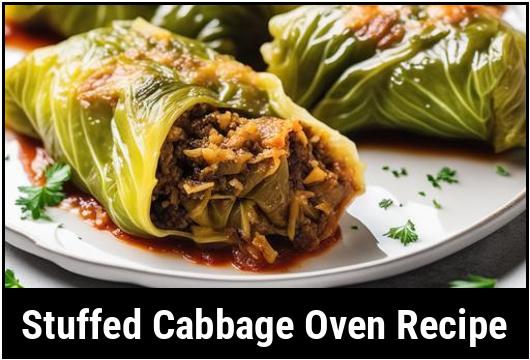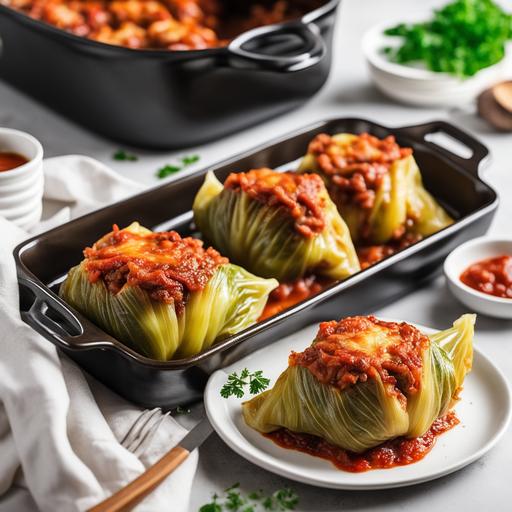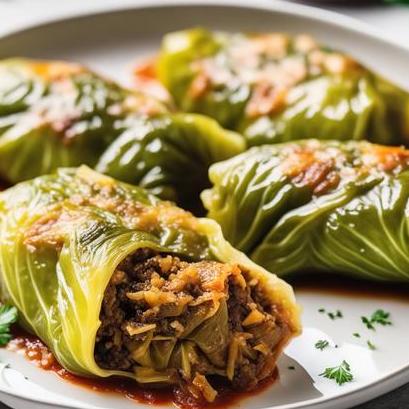
Comprehensive Guide To A Delicious Stuffed Cabbage Oven Recipe
Welcome to this comprehensive guide on how to make a mouthwatering stuffed cabbage dish right in your own kitchen! Stuffed cabbage, also known as "golubtsy" or "halupki" in Eastern European cuisine, is a beloved comfort food that combines tender cabbage leaves with a flavorful filling, all baked to perfection. In this article, we will delve into the food science behind this delightful dish, provide detailed culinary instructions, offer helpful tips and variations, and even discuss how to check for doneness. So let’s roll up our sleeves and get started!
Food Science: Cabbage and its Characteristics
Before we jump into the practical aspects of making stuffed cabbage, it’s essential to understand the ingredients we are working with. Cabbage, a cruciferous vegetable, belongs to the Brassica family and is renowned for its versatility in various culinary traditions. It has a dense and crunchy texture with a subtly sweet flavor that melds well with a wide range of fillings.
Cabbage is not only delicious but also packs a nutritional punch. It is an excellent source of Vitamin C, Vitamin K, and dietary fiber. Moreover, cabbage is low in calories and high in antioxidants, making it a fantastic addition to a balanced diet.
Selecting the Perfect Cabbage
When it comes to selecting a cabbage for your stuffed cabbage recipe, there are a few crucial things to consider. First and foremost, choose a cabbage head that feels firm and heavy for its size. Avoid cabbages with discolored outer leaves or any signs of wilting.
Additionally, the size of the cabbage head matters. For stuffed cabbage, opt for a medium-sized cabbage that will yield leaves of suitable size for rolling. Remember that the outer leaves will be used for wrapping, so make sure they are large enough to hold the filling without tearing.
Cleaning the Cabbage

Once you have selected the ideal cabbage, it’s time to give it a good clean. Begin by removing the wilted or damaged outer leaves. Next, rinse the cabbage head under cool running water, rubbing gently to remove any dirt or debris that may be trapped between the leaves. Afterward, pat the cabbage dry using a clean kitchen towel.
Preparation: Softening the Cabbage Leaves
Preparing the cabbage leaves for stuffing is a crucial step in achieving a delectable stuffed cabbage dish. Most recipes call for blanching the cabbage leaves to soften them, making them easier to manipulate and roll.
To blanch the cabbage leaves, bring a large pot of salted water to a boil. Carefully immerse the whole cabbage head into the boiling water, holding it by the stem. As the outer leaves begin to wilt, use tongs to remove them from the hot water and transfer them to an ice bath. The ice bath will halt the cooking process and help retain the vibrant green color.
Once the cabbage leaves have cooled in the ice bath for a few minutes, drain them thoroughly and set them aside. Trim away the thick rib from the base of each leaf, as it can hinder the rolling process.
Crafting a Flavorful Filling

The filling is the heart of any stuffed cabbage recipe. While there are numerous variations depending on regional and personal preferences, the main traditional ingredients often include ground meat, cooked rice, onions, garlic, and spices.
Start by sautéing finely chopped onions and minced garlic in a skillet until they turn translucent and release their aromatic flavors. The onions should develop a gentle caramelized sweetness.
Next, combine the sautéed onions and garlic with ground meat (commonly beef, pork, or a combination of the two) in a mixing bowl. To enhance the flavors, add cooked rice, herbs like parsley or dill, and an array of spices such as paprika, black pepper, and salt. Mix the ingredients thoroughly to ensure a homogeneous and well-seasoned filling.
Assembly: Rolling Stuffed Cabbage
With the cabbage leaves blanched and the filling prepared, it’s time to assemble the rolls. Take a cabbage leaf and place a spoonful of the filling in the center, near the trimmed end. Gently fold the leaf’s sides over the filling and roll it tightly, much like a burrito or spring roll. Place the rolled cabbage leaf seam-side down in a baking dish, and repeat this process with the remaining leaves.
Tips for Success

Creating a fantastic stuffed cabbage dish requires careful attention to detail. Here are some tips to ensure your cabbage rolls turn out spectacular:
-
Choosing the right ground meat: The choice of ground meat significantly impacts the flavor and texture of your filling. Experiment with combinations like beef and pork or consider using ground turkey or chicken for a leaner option.
-
Herb-infused flavors: Apart from parsley and dill, feel free to explore other herbs such as thyme, basil, or rosemary to add aromatic notes to your filling.
-
Adding veggies: Enhance the nutritional profile by incorporating finely chopped vegetables like carrots or bell peppers into your stuffing mixture.
-
Parboiling the cabbage head: As an alternative to blanching individual leaves, some recipes call for parboiling the entire cabbage head. This method allows for easier separation of the leaves while still achieving the desired softness.
-
Sauerkraut twist: For a tangy and unique twist on the traditional recipe, layer sauerkraut between the cabbage rolls before baking. This adds complexity and an appealing sour flavor to the dish.
-
Customizing the sauce: While many stuffed cabbage dishes are baked in tomato-based sauces, don’t be afraid to experiment. Consider a creamy mushroom sauce or a zesty lemon-infused gravy to complement the flavors.
Baking and Doneness Checks
Once your stuffed cabbage rolls are perfectly formed and arranged in the baking dish, it’s time to pop them into the oven! Preheat the oven to a moderate temperature, usually around 350°F (175°C).
The baking time may vary depending on the size of the cabbage rolls and the individual recipe. Most stuffed cabbage dishes require approximately 45 minutes to an hour of baking. To ensure the rolls are cooked through, use a digital meat thermometer to check the internal temperature of the filling. The thermometer should read at least 160°F (71°C), indicating that the meat is thoroughly cooked.
Serving Suggestions and Enjoyment

The moment your stuffed cabbage rolls are beautifully browned and cooked to perfection, it’s time to serve and enjoy this delightful dish! Here are a few serving suggestions and accompaniments to enhance the experience:
-
Garnish with herbs: Sprinkle freshly chopped parsley or dill over the stuffed cabbage rolls before serving. This adds a vibrant touch of green and freshness to the dish.
-
Side dishes: Pair your stuffed cabbage with classic accompaniments like fluffy mashed potatoes, tangy sauerkraut, or pickles. The contrasting flavors and textures elevate the overall meal.
-
Serving sauce: Drizzle some of the sauce from the baking dish over the rolls before serving. This imparts additional moisture and enhances the flavors.
-
Leftovers: If you happen to have leftovers (which are rare due to the dish’s undeniable popularity), stuffed cabbage rolls can be refrigerated and enjoyed for up to three days. They often taste even better the next day as the flavors meld.
Variations and Innovations
While the traditional stuffed cabbage recipe is undoubtedly a culinary masterpiece, there is always room for innovation and personal touch. Consider trying one of these delightful variations:
-
Vegetarian twist: Substitute the meat filling with a mixture of quinoa, mushrooms, and lentils for a vegetarian and protein-rich alternative.
-
International flavors: Experiment with global spices and seasonings to create fusion-style stuffed cabbage rolls. Consider adding cumin, turmeric, or curry powder for an Indian-inspired twist or go for a Greek influence with feta cheese and oregano.
-
Seafood surprise: For seafood enthusiasts, seafood-stuffed cabbage rolls can be a delightful treat. Swap the ground meat with a combination of shrimp, crab, or whitefish, seasoned with herbs and spices of your choice.
Conclusion
In conclusion, crafting a delectable stuffed cabbage dish allows you to combine various flavors and textures into a single comforting and nutritious meal. With the guidance provided in this comprehensive article, you are armed with the knowledge to create a truly outstanding stuffed cabbage oven recipe. From selecting the perfect cabbage to incorporating flavorful variations, you now have all the tools needed to impress your family and friends with this delicious Eastern European classic. So tie on your apron, gather your ingredients, and embark on a culinary journey that will surely satisfy your taste buds and warm your soul!
Sources
FAQS On Stuffed Cabbage Oven Recipe
What Ingredients Do I Need For A Stuffed Cabbage Oven Recipe?
To make stuffed cabbage in the oven, you will need the following ingredients:
- 1 large head of cabbage
- 1 cup cooked rice
- 1 pound ground beef or turkey
- 1 small onion, finely chopped
- 2 cloves garlic, minced
- 1 egg
- 1 teaspoon salt
- 1/2 teaspoon black pepper
- 1/2 teaspoon paprika
- 1/4 teaspoon dried thyme
- 1/4 teaspoon dried oregano
- 1 can tomato sauce (15 ounces)
- 1 can diced tomatoes (14.5 ounces)
- 1/4 cup brown sugar
- 2 tablespoons lemon juice
How Do I Prepare The Cabbage For Stuffing?
Start by carefully removing the outer leaves of the cabbage. Bring a large pot of water to a boil and blanch the cabbage leaves for a couple of minutes until they become pliable and tender. Once done, remove the leaves from the boiling water and set them aside to cool. Meanwhile, continue to boil the remaining head of cabbage until the inner leaves are soft and can be easily separated. Remove these softened leaves and set aside as well.
What Is The Procedure For Stuffing The Cabbage Leaves?
To stuff the cabbage leaves, take a leaf and place a small amount of filling (a mixture of cooked rice and ground meat) in the center. Roll the leaf tightly, tucking in the sides as you go. Repeat this process with the remaining cabbage leaves and filling until all the leaves are stuffed.
How Do I Prepare The Tomato Sauce For The Stuffed Cabbage?
In a mixing bowl, combine the tomato sauce, diced tomatoes, brown sugar, and lemon juice. Stir well until the brown sugar is dissolved and the ingredients are thoroughly combined.
What Is The Cooking Process For The Stuffed Cabbage In The Oven?
Preheat your oven to 375°F (190°C). In a large baking dish, spread a thin layer of the prepared tomato sauce mixture. Arrange the stuffed cabbage rolls on top of the sauce. Pour the remaining sauce over the stuffed cabbage rolls, ensuring they are fully covered. Cover the baking dish with foil and bake in the preheated oven for about 45 minutes to 1 hour, or until the cabbage is tender and the filling is cooked through. Serve hot and enjoy!



